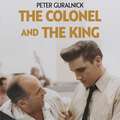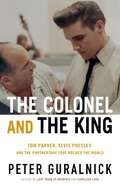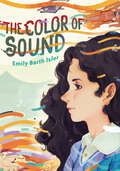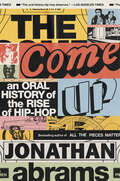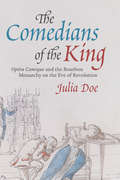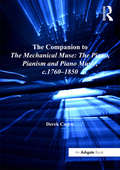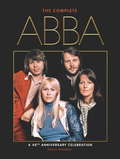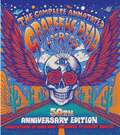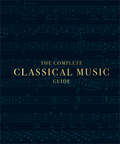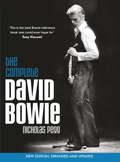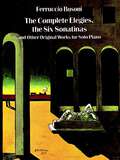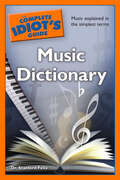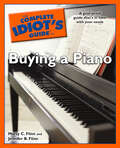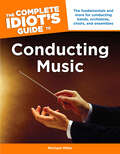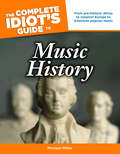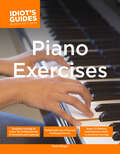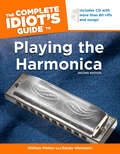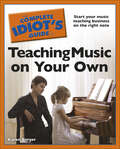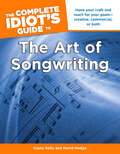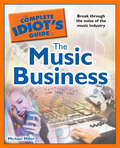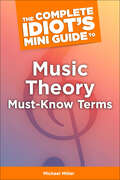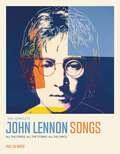- Table View
- List View
The Colonel and the King: Tom Parker, Elvis Presley and the Partnership that Rocked the World
by Peter GuralnickIn early 1955, Colonel Tom Parker (the manager of the number-one country music star of the day) heard that an unknown teenager from Memphis had just drawn a crowd of more than 800 people to a Texas schoolhouse and headed south to investigate. Within a matter of days, Parker was sending out telegrams and letters to promoters and booking agents: 'We have a new boy that is absolutely going to be one of the biggest things in the business in a very short time. His name is ELVIS PRESLEY.' The close personal bond between Elvis and the Colonel is something that has never been fully portrayed before. It was a relationship founded on mutual admiration and support. From the outset, the Colonel defended Elvis fiercely and indefatigably against RCA executives, Elvis' own booking agents and movie moguls. But in their final years together, the story grew darker, as the Colonel found himself unable to protect Elvis from himself - or to control growing problems of his own. Featuring troves of previously unpublished correspondence from the Colonel's own archives, revelatory for both their insights and their emotional depth, The Colonel and the King provides a groundbreaking dual portrait of the relationship between the iconic artist and his legendary manager and a unique perspective on not one but two American originals. A tale of the birth of the modern-day superstar (an invention almost entirely of Parker's making) by the most acclaimed music writer of his generation, it presents these two misunderstood icons as they've never been seen before: with all of their brilliance, humour and flaws on full display.
The Colonel and the King: Tom Parker, Elvis Presley and the Partnership that Rocked the World
by Peter GuralnickIn early 1955, Colonel Tom Parker (the manager of the number-one country music star of the day) heard that an unknown teenager from Memphis had just drawn a crowd of more than 800 people to a Texas schoolhouse and headed south to investigate. Within a matter of days, Parker was sending out telegrams and letters to promoters and booking agents: 'We have a new boy that is absolutely going to be one of the biggest things in the business in a very short time. His name is ELVIS PRESLEY.' The close personal bond between Elvis and the Colonel is something that has never been fully portrayed before. It was a relationship founded on mutual admiration and support. From the outset, the Colonel defended Elvis fiercely and indefatigably against RCA executives, Elvis' own booking agents and movie moguls. But in their final years together, the story grew darker, as the Colonel found himself unable to protect Elvis from himself - or to control growing problems of his own. Featuring troves of previously unpublished correspondence from the Colonel's own archives, revelatory for both their insights and their emotional depth, The Colonel and the King provides a groundbreaking dual portrait of the relationship between the iconic artist and his legendary manager and a unique perspective on not one but two American originals. A tale of the birth of the modern-day superstar (an invention almost entirely of Parker's making) by the most acclaimed music writer of his generation, it presents these two misunderstood icons as they've never been seen before: with all of their brilliance, humour and flaws on full display.
The Colonel and the King: Tom Parker, Elvis Presley, and the Partnership that Rocked the World
by Peter GuralnickFrom the award-winning biographer of Elvis Presley, a groundbreaking dual portrait of the relationship between the iconic artist and his legendary manager—drawing on a wealth of the Colonel's never-before-seen correspondence to reveal that this oft-reviled figure was in fact a confidant, friend, and architect of his client&’s success In early 1955, Colonel Tom Parker—manager of the number-one country music star of the day—heard that an unknown teenager from Memphis had just drawn a crowd of more than eight hundred people to a Texas schoolhouse, and headed south to investigate. Within days, Parker was sending out telegrams and letters to promoters and booking agents: &“We have a new boy that is absolutely going to be one of the biggest things in the business in a very short time. His name is ELVIS PRESLEY.&” Later that year, after signing with RCA, the young man sent a telegram of his own: &“Dear Colonel, Words can never tell you how my folks and I appreciate what you did for me.... I love you like a father.&” The close personal bond between Elvis and the Colonel has never been fully portrayed before. It was a relationship founded on mutual admiration and support. From the outset, the Colonel defended Elvis fiercely and indefatigably against RCA executives, Elvis&’s own booking agents, and movie moguls. But in their final years together, the story grew darker, as the Colonel found himself unable to protect Elvis from himself or control growing problems of his own. Featuring troves of previously unpublished correspondence, revelatory for both its insights and emotional depth, The Colonel and the King provides a unique perspective on not one but two American originals. A tale of the birth of the modern-day superstar (an invention almost entirely of Parker&’s making) by Peter Guralnick, the most acclaimed music writer of his generation, it presents these two misunderstood icons as they&’ve never been seen before: with all of their brilliance, humor, and flaws on full display.
The Color of Sound
by Emily Barth Isler"[A] salient celebration of family, music, and neurodiversity." —starred, Publishers Weekly "A top pick for any middle school collection; a perfect book club pick and a reminder to all that patience and understanding can change lives." —starred, School Library Journal Twelve-year-old Rosie is a musical prodigy whose synesthesia allows her to see music in colors. She’s never told anyone this, though. She already stands out more than enough as a musical “prodigy” who plays better than most adults. Rosie’s mom expects her to become a professional violinist. But this summer, Rosie refuses to play. She wants to have a break. To make friends and discover new hobbies. To find out who she would be if her life didn’t revolve around the violin. So instead of attending a prestigious summer music camp, Rosie goes with her mom to visit her grandparents. Grandma Florence’s health is failing, Grandpa Jack doesn’t talk much, and Rosie’s mom is furious with her for giving up the violin. But Rosie is determined to make the most of her “strike.” And when she meets a girl who seems distinctly familiar, she knows this summer will be unlike any other. With help from a mysterious glitch in time—plus her grandparents, an improv group, and a new instrument—Rosie uncovers secrets that change how she sees her family, herself, and the music that’s always been part of her.
The Come Up: An Oral History of the Rise of Hip-Hop
by Jonathan AbramsThe essential oral history of hip-hop, from its origins on the playgrounds of the Bronx to its reign as the most powerful force in pop culture—from the award-winning journalist behind All the Pieces Matter, the New York Times bestselling oral history of The Wire &“The Come Up is Abrams at his sharpest, at his most observant, at his most insightful.&”—Shea Serrano, #1 New York Times bestselling author of Hip-Hop (And Other Things) The music that would come to be known as hip-hop was born at a party in the Bronx in the summer of 1973. Now, fifty years later, it&’s the most popular music genre in America. Just as jazz did in the first half of the twentieth century, hip-hop and its groundbreaking DJs and artists—nearly all of them people of color from some of America&’s most overlooked communities—pushed the boundaries of music to new frontiers, while transfixing the country&’s youth and reshaping fashion, art, and even language.And yet, the stories of many hip-hop pioneers and their individual contributions in the pre-Internet days of mixtapes and word of mouth are rarely heard—and some are at risk of being lost forever. Now, in The Come Up, the New York Times bestselling author Jonathan Abrams offers the most comprehensive account so far of hip-hop&’s rise, a multi-decade chronicle told in the voices of the people who made it happen. In more than three hundred interviews conducted over three years, Abrams has captured the stories of the DJs, executives, producers, and artists who both witnessed and themselves forged the history of hip-hop. Masterfully combining these voices into a seamless symphonic narrative, Abrams traces how the genre grew out of the resourcefulness of a neglected population in the South Bronx, and from there how it flowed into New York City&’s other boroughs, and beyond—from electrifying live gatherings, then on to radio and vinyl, below to the Mason-Dixon Line, west to Los Angeles through gangster rap and G-funk, and then across generations. Abrams has on record Grandmaster Caz detailing hip-hop&’s infancy, Edward &“Duke Bootee&” Fletcher describing the origins of &“The Message,&” DMC narrating his role in introducing hip-hop to the mainstream, Ice Cube recounting N.W.A&’s breakthrough and breakup, Kool Moe Dee recalling his Grammys boycott, and countless more key players. Throughout, Abrams conveys with singular vividness the drive, the stakes, and the relentless creativity that ignited one of the greatest revolutions in modern music. The Come Up is an exhilarating behind-the-scenes account of how hip-hop came to rule the world—and an essential contribution to music history.
The Comedians of the King: Opéra Comique and the Bourbon Monarchy on the Eve of Revolution
by Julia DoeLyric theater in ancien régime France was an eminently political art, tied to the demands of court spectacle. This was true not only of tragic opera (tragédie lyrique) but also its comic counterpart, opéra comique, a form tracing its roots to the seasonal trade fairs of Paris. While historians have long privileged the genre’s popular origins, opéra comique was brought under the protection of the French crown in 1762, thus consolidating a new venue where national music might be debated and defined. In The Comedians of the King, Julia Doe traces the impact of Bourbon patronage on the development of opéra comique in the turbulent prerevolutionary years. Drawing on both musical and archival evidence, the book presents the history of this understudied genre and unpacks the material structures that supported its rapid evolution at the royally sponsored Comédie-Italienne. Doe demonstrates how comic theater was exploited in, and worked against, the monarchy’s carefully cultivated public image—a negotiation that became especially fraught after the accession of the music-loving queen, Marie Antoinette. The Comedians of the King examines the aesthetic and political tensions that arose when a genre with popular foundations was folded into the Bourbon propaganda machine, and when a group of actors trained at the Parisian fairs became official representatives of the sovereign, or comédiens ordinaires du roi.
The Companion to The Mechanical Muse: The Piano, Pianism and Piano Music, c.1760–1850
by Derek CarewIntended as a supplement to The Mechanical Muse: The Piano, Pianism and Piano Music, c.1760-1850, this Companion provides additional information which, largely for reasons of space but also of continuity, it was not possible or desirable to include in that volume. The book is laid out alphabetically and full biographical entries are provided for all musical figures mentioned, including composers, performers, theoreticians and teachers, as well as piano makers and publishers of music, within the period covered by The Mechanical Muse. There are also entries on figures of importance from outside the period but whose influence is palpably important within it, such as J.S. Bach. As well as biographical information, all these entries contain lists of principal works and a section on further reading so that readers can follow up people and matters of particular interest. Also included in The Companion are entries devoted to particular works and other information of relevance, such as descriptions of musical forms, characteristics of dances and so on, as well as some technical information on music and explanations of technical terms pertaining to keyboard instruments themselves and to ways of playing them. This Companion is not intended to replace existing reference books such as Grove or Musik in Geschichte und Gegenwart, but will be useful for those who desire to know more about a particular topic and do not necessarily have access to more specialist reference works, or time to visit large or specialist libraries. As such it is indispensable to users of The Mechanical Muse.
The Complete ABBA (40th Anniversary Edition)
by Simon SheridanFor four decades ABBA - the combined talents of Agnetha Fältskog, Björn Ulvaeus, Benny Andersson and Anni-Frid Lyngstad - has been a global music phenomenon, clocking up record sales of over 360 million. For the very first time The Complete ABBA compiles all of the Swedish supergroup's singles, albums, TV specials, tours and movies. Beginning with their 1972 debut single People Need Love, the book chronicles the band's incredible story right through to Björn and Benny's triumphant Thank You for the Musictribute concert held in London in 2009, and beyond, to 2012, the band's 40th anniversary. This is all the ABBA you'll ever need!
The Complete Annotated Grateful Dead Lyrics
by David G. DoddCelebrate the fiftieth anniversary of the most popular and enduring band ever: &“Even the most hardcore Deadheads will be impressed by this obsessively complete look at the Grateful Dead&’s lyrics&” (Publishers Weekly).The Complete Annotated Grateful Dead Lyrics is an authoritative text, providing standard versions of all the original songs you thought you knew forwards and backwards. These are some of the best-loved songs in the modern American songbook. They are hummed and spoken among thousands as counterculture code and recorded by musicians of all stripes for their inimitable singability and obscure accessibility. How do they do all this? To provide a context for this formidable body of work, of which his part is primary, Robert Hunter has written a foreword that goes to the heart of the matter. And the annotations on sources provide a gloss on the lyrics, which goes to the roots of Western culture as they are incorporated into them. An avid Grateful Dead concertgoer for more than two decades, David Dodd is a librarian who brings to the work a detective’s love of following a clue as far as it will take him. Including essays by Dead lyricists Robert Hunter and John Perry and Jim Carpenter’s original illustrations, whimsical elements in the lyrics are brought to light, showcasing the American legend that is present in so many songs. A gorgeous keepsake edition of the Dead’s official annotated lyrics, The Complete Annotated Grateful Dead Lyrics is an absolute must-have for the fiftieth anniversary—you won’t think of this cultural icon the same way again. In fact, founding band member Bob Weir said: “This book is great. Now I’ll never have to explain myself.”
The Complete Classical Music Guide (DK Ultimate Guides)
by DKPacked with photographs, composer biographies, analyses of major works, and essential information on every musical genre, style, form, instrument, and ensemble, DK's Complete Classical Music Guide is a portable encyclopedic guide to more than one thousand years of Western classical music. From Bach to Berlioz, Glinka to Gershwin, Stravinsky to Shostakovich, and everyone in between, the Complete Classical Music Guide contains more than three hundred composer profiles, and offers a clear definition of the particular styles and characteristics of seven key eras: Early Music (1000-1600); The Baroque Era (1600-1750); The Classical Era (1750-1820); The Romantic Era (1810-1920); Romantic Opera (1810-1920); National Schools (1830-1950); and Modern Music (1900-). The Complete Classical Music Guide also includes a timeline that charts the evolution of musical styles and forms, instruments, and provides explanations of the building blocks of music — melody, harmony, rhythm, texture, form, tempo, and dynamics. Previously published as Eyewitness Companion: Classical Music, this book has been reformatted and designed and now comes packaged in an exclusive presentation slipcase.
The Complete David Bowie
by Nicholas PeggThe biggest edition yet - expanded and updated with 35,000 words of new material Critically acclaimed in its previous editions, The Complete David Bowie is widely recognized as the foremost source of analysis and information on every facet of Bowie's career. The A-Z of songs and the day-by-day dateline are the most complete ever published. From the 11-year-old's skiffle performance at the 18th Bromley Scouts' Summer Camp in 1958, to the emergence of the legendary lost album Toy in 2011, The Complete David Bowie discusses and dissects every last development in rock's most fascinating career. * The Albums - detailed production history and analysis of every album from 1967 to the present day. * The Songs - hundreds of individual entries reveal the facts and anecdotes behind not just the famous recordings, but also the most obscure of unreleased rarities - from 'Absolute Beginners' to 'Ziggy Stardust', from 'Abdulmajid' to 'Zion'. * The Tours - set-lists and histories of every live show. * The Actor - a complete guide to Bowie's career on stage and screen. * Plus - the videos, the BBC radio sessions, the paintings, the Internet and much more.
The Complete Elegies, The Six Sonatinas: and Other Original Works for Solo Piano (Dover Classical Piano Music)
by Ferruccio BusoniLike Franz Liszt, Ferruccio Busoni (1866-1924) first earned a worldwide reputation as an extraordinary pianist, and only later turned his efforts to composing. Although he is widely known for his virtuoso transcriptions of music by Bach and Liszt, his original piano compositions are today highly regarded for their combination of technical brilliance and innovative ideas.This modestly priced volume brings together the best and most important Busoni original solo piano works: the seven Elegies; the six Sonatinas; the enormous and complex Contrapuntal Fantasy; the Fantasy after J. S. Bach; the Indian Diary (four piano studies on American Indian motifs); and the six Pieces, Op. 33b. Serious pianists and students of piano music will want to have this impressive and important new compilation in their music libraries.
The Complete History of Black Sabbath: What Evil Lurks
by Joel McIverThe definitive history of the band that invented heavy metal—featuring rare photographs, a complete discography and an introduction by Robb Flynn.With its infernal sound and dark lyrics, Black Sabbath has been a force of nature for half a century. Its career spans eleven different line-ups and nineteen studio albums in addition to the twenty-eight solo albums of the original four members.The band began in 1968, playing blues rock on the cover circuit of Birmingham, England. But guitarist Tony Iommi, bassist Geezer Butler, singer Ozzy Osbourne, and drummer Bill Ward would soon define a new genre of music—and make themselves world famous.Joel McIver explores the complete history of Sabbath, from precursor bands to history-making albums and on to the present. With more than 150 photos, a gatefold family tree tracing the development of the band, a complete discography, and a foreword by Machine Head frontman Robb Flynn, this is the must-have book for any Sabbath fan.
The Complete Idiot's Guide Music Dictionary: Music Explained in the Simplest Terms
by Dr. Stanford FelixA musician's vocabulary needs more than Do, Re, Mi... Written in clear, concise, easy-to-understand language, The Complete Idiot's Guide® Music Dictionary covers a multitude of musical aspects indispensable to any musician. Author and music professor Stanford Felix has compiled the most commonly found terms and explains them in a way that even the most novice musician can comprehend. • The only dictionary geared toward the beginner musician • Gives clear, concise definitions of terms, theories, and instruments, as well as important works, musicians, and composers
The Complete Idiot's Guide to Buying a Piano: A Goof-Proof Guide That’s in Tune with Your Needs
by Jennifer B. Flinn Marty C. FlinnTune in and tone down piano-shopping stress. Unfamiliar with manufacturers, manufacturing methods, materials, or price ranges, the piano buyer can still educate himself before making the big investment, saving time, money, and frustration. This is the first book written by salespeople that dispels myths and airs dirty tricks, making it an easy–to–use buyer&’s guide for all the well known, and many of the not–so–well known, piano models. • How to choose from new or used, digital or acoustic, upright, grand, hybrid, or player pianos • Nearly half a million pianos are purchased annually in the United States, with Americans spending nearly $1.7 billion a year on them • Piano technicians and teachers require this accurate information to dispense advice on buying
The Complete Idiot's Guide to Conducting Music: The Fundamentals and More for Conducting Bands, Orchestras, Choirs, and Ensemble
by Michael MillerThe complex art of conducting may look effortless to the casual onlooker, however, it requires a great deal of knowledge and skill. The success of a performance hinges on the director's ability to keep the group playing together and interpreting the music as the composer intended. The Complete Idiot's Guide® to Conducting Music shows student and novice conductors how to lead bands, orchestras, choirs, and other ensembles effectively through sight-reading, rehearsals, and performances.
The Complete Idiot's Guide to Music History: From Pre-Historic Africa to Classical Europe to American Popular Music
by Michael MillerA beautifully composed journey through music history!Music history is a required course for all music students. Unfortunately, the typical music history book is dry and academic, focusing on rote memorization of important composers and works. This leads many to think that the topic is boring, but bestselling author Michael Miller proves that isn&’t so. This guide makes music history interesting and fun, for both music students and older music lovers.• Covers more than Western &“classical&” music—also includes non-Western music and uniquely American forms such as jazz• More than just names and dates—puts musical developments in context with key historical events
The Complete Idiot's Guide to Piano Exercises
by Karen BergerMake sure you hit all the right notes Playing the piano is much more than just learning notes and reading music; having good dexterity, building independent finger strength, and learning proper technique is absolutely essential to mastering the instrument. Packed with everything a player needs to become a great pianist, The Complete Idiot's Guide® to Piano Exercises is the perfect companion to the best-selling The Complete Idiot's Guide® to Playing Piano, Third Edition. • More than 100 challenging exercises designed to improve playing skills, including pedaling, hand crossovers, virtuoso arpeggios, playing dynamics, and more • The author owns and operates a very successful home studio, and is a virtuoso pianist
The Complete Idiot's Guide to Playing the Harmonica, 2nd Edition
by Randy Weinstein William MeltonThe harmonica is one of the most traditional musical instruments in America. Millions are sold each year, but there are few high-quality, comprehensive instructional manuals for new harmonica players. This bestselling book has been completely updated, with dozens of new songs. • Over 100 songs, both traditional and original to this book. • Detailed instructions on playing, including photos to illustrate positions and techniques. • Buying tips and interesting historical facts about famous players. • Authors are professional musicians. • The most comprehensive music lists featuring nearly every style of playing and category of song. • Comprehensive resource guides.
The Complete Idiot's Guide to Teaching Music on Your Own
by Karen BergerA pitch-perfect resource that will be a number-one hit with music instructors The Complete Idiot's Guide® to Teaching Music on Your Own offers prospective teachers-and existing ones-all of the tools they need to start and run a profitable, respected studio. The comprehensive guide covers every aspect of running a studio, including: • Setting up a studio • Lessons in the home versus traveling to students • Advertising and marketing • Fee schedules and basic pricing principles • Student relations • Using computer games and programs in the studio
The Complete Idiot's Guide to the Art of Songwriting: Home Your Craft and Reach for Your Goals—Creative, Commercial, or Both
by David Hodge Casey KellyNow newbie songwriters can learn the craft—and sing their own praises online Beginning songwriters can hit the right note by starting out with the basics in this guide, including: • How to create melodies • How to create many different harmonies • Techniques using deliberate rhythm and stylistic changes • How to enable one's songwriting to grow and evolve • How to deal with songwriter's block • The best places to upload one's work for maximum exposure and opportunities
The Complete Idiot's Guide to the Music Business: Break Through the Noise of the Music Industry
by Michael MillerInstrumental in turning musicians into moneymakers The Complete Idiot's Guide® to the Music Business is written for every musician who needs to learn the business of music, as well as for all businesspeople entering the music industry. Author Michael Miller covers all the key business topics and reveals the wealth of job opportunities in the music industry from a business perspective. • Covers finding an agent, negotiating contracts, publishing songs, collecting royalties, and promotion strategies • Also covers such nonmusician industry careers as artist management, concert promotion, music production, and radio • Features essential information on the new frontiers of electronic and online music
The Complete Idiot's Mini Guide to Music Theory Must-Know Terms
by Michael MillerYou have a passion for making beautiful music, but when it comes to understanding and speaking the musical language, you need a little help. The Complete Idiot's Mini Guide to Music Theory Must-Know Terms compiles dozens of the most important and commonly used terms in the musical lexicon - from notations and chords to modes and scales - explaining them all in clear, concise language.
The Complete John Lennon Songs: All the Songs. All the Stories. All the Lyrics.
by Paul Du NoyerINCLUDES COMPLETE JOHN LENNON LYRICS FOR THE FIRST TIMELennon's life after the Beatles was eventful and fascinating. He moved from stardom in the world's biggest pop group to global peace campaigner and figurehead for radical causes. He left England for a new life in the USA with Yoko Ono. He later abandoned public life and retired to his New York apartment to raise their son and live the life of a recluse. In 1980 he re-emerged with a new album, but the plan to resume his career was cruelly curtailed on a fateful night outside the Dakota Building when he was murdered.Upon first publication, this book was the first to examine and assess all of John Lennon's solo work. This updated edition includes lyrics and is released on the 40th anniversary of his death and the 80th anniversary of his birth.
The Complete John Lennon Songs: All the Songs. All the Stories. All the Lyrics.
by Paul Du NoyerINCLUDES COMPLETE JOHN LENNON LYRICS FOR THE FIRST TIMELennon's life after the Beatles was eventful and fascinating. He moved from stardom in the world's biggest pop group to global peace campaigner and figurehead for radical causes. He left England for a new life in the USA with Yoko Ono. He later abandoned public life and retired to his New York apartment to raise their son and live the life of a recluse. In 1980 he re-emerged with a new album, but the plan to resume his career was cruelly curtailed on a fateful night outside the Dakota Building when he was murdered.Upon first publication, this book was the first to examine and assess all of John Lennon's solo work. This updated edition includes lyrics and is released on the 40th anniversary of his death and the 80th anniversary of his birth.
